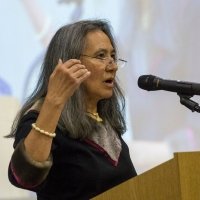The Use of Indigenous Traditional Knowledge in Climate Change Strategies
Submit a question
“Tribal People have learned to take care of the land because our land took care of us,” said Kat Brigham, Chair of the Board of Trustees for the Confederated Tribes of the Umatilla Indian Reservation (CTUIR), at a recent Wilson Center event. “It’s important for tribal people to be at the table. We have a lot of knowledge, we have a lot of experience on how to protect and restore natural resources,” said Brigham. “This is part of our culture, our history, and our future.”
Protecting cultural integrity
For Indigenous communities, climate calamity threatens livelihoods, environments, and cultural integrity, said Dalee Sambo Dorough, Chair of the Inuit Circumpolar Council.
Preserving the cultural integrity of tribal people requires redressing historical injustices and upholding American Indian rights, said Brigham. “We push hard to make sure our treaty rights are being protected in rebuilding our natural resources not only for today but for future generations—our children’s children.” The United States vs. Oregon ruling was a step in this direction. U.S. District Court Judge Robert Belloni’s decision in this ongoing case restricted state regulatory authority over fisheries along the Columbia River and held that tribes reserved exclusive rights to half of the harvestable fish runs across Indigenous fishing grounds. Because of this ruling, said Brigham, Columbia River Treaty tribes were able to better coordinate Columbia River fish management plans to manage, enhance, and rebuild the river’s fishery resources.
Judicial processes, however, more often reap incremental gains rather than structural change and Indigenous communities’ inclusion in decision-making remains a slow, uphill battle. Tribal groups continue to encounter obstacles, for example, in access to negotiations over the Columbia River Treaty and related struggles, including reclaiming ancestral land that has been appropriated or privatized.
Integrating Indigenous knowledge in climate solutions
There is growing recognition that Indigenous perspectives should be front and center in climate change responses, said Dorough. From the nomination of Representative Deb Haaland as Secretary of the Interior to the Inuit Circumpolar Council’s engagement at convenings of the Conference of the Parties and the release of the Status of Tribes and Climate Change Report, Indigenous groups’ decades-long activism is elevating Indigenous knowledge systems at the local, national, and international levels, said Dorough.
Brigham shared an example of how the CTIUR is showing the applicability of their natural management approach. The creation belief of the CTUIR has shaped their approach to managing resources in ways that “align human values and management goals with ecosystem resilience.” Stemming from the reciprocal relationship between ecosystems and people, the First Food management approach puts forth that Indigenous people have a moral obligation to safeguard First Foods—berries, roots, big game, salmon, water—the same way these resources nourish and nurture them. “It’s the circle of life,” said Brigham. “If you have a negative impact on one, you have a negative impact on all.” The First Foods organizing principle—shared by the CTUIR in an Ecology and Society article, is an example of how Tribal communities are working to help translate their knowledge and technical expertise for non-Indians.
Cooperation is essential in diversifying funding channels, said Brigham. Internationally, finance poses a barrier to Indigenous-led climate change action. Fiscal resources are usually distributed according to the false Global North and Global South binary, said Dorough. This dichotomy obscures the fact that many Indigenous people in developed nations face impoverished conditions and are often heavily impacted by climate change. State party members of the UN Framework Convention on Climate Change must better understand climate impacts upon Indigenous people, said Dorough. After all, Indigenous territories hold 80 percent of the world’s biodiversity. Ensuring tribal groups have access to capital is critical to our collective duty to protect Indigenous rights and the planet.
Centering Indigenous communities and countering colonialism
For Indigenous youth in particular, questions of identity, culture, and their future in a warming world are steeped in uncertainty, said Dorough. Yet, “the upside is that they can take action.” They can raise their voices to share what they are seeing, learning, and have learned. To counter feelings of anxiety, said Brigham, young people should remain grounded and rooted to Indigenous intergenerational teachings. “Passing on that traditional knowledge is very important so that [Indigenous youth] learn, and they can work to protect that knowledge.”
Regarding Indigenous voices and the scientific community, Dorough said climate mitigation and adaptation projects must be co-developed by analysts and Indigenous groups. Outreach to tribes must occur from the outset of the research process, said Brigham. In the long-term, ethical and equitable engagement of Indigenous knowledge is predicated on trust, said Dorough. “It comes down to respect for who we are, our identity, and what we have to offer.”
To enhance salmon runs along the Columbia River, for instance, Brigham said the Bonneville Power Administration approached the Nez Perce Tribe, Confederated Tribes of the Umatilla Indian Reservation, Confederated Tribes of Warm Springs, and the Confederated Tribes and Bands of the Yakama Nation, noting that Indigenous communities should be involved in the first steps of strategic planning and implementation. Out of this partnership emerged the Columbia River Inter-Tribal Fish Commission, a technical body that provides assistance to the tribes in enlarging the salmon population size. These joint conservation efforts “benefit not only us but [all] people working in this region,” said Brigham.
“We are keen to co-produce knowledge because, in our estimation, policy and decision-makers… need to have the best available knowledge to make decisions that are going to be favorable for all of humanity—not just Inuit, not just Umatilla, but all of us,” said Dorough.
Read More:
- In Ecuador, Indigenous Environmental Attitudes Affected by Proximity to Oil Extraction
- Indigenous Ingenuity Frequently Overlooked in Climate Change Discussions
- New Investment Law in Peru Undermines Rights of Indigenous Women
- Environmentalists and Indigenous Peoples: Natural Allies?
Written by Shruti Samala, edited by Lauren Risi.
Continue the conversation on Twitter @NewSecurityBeat. Find related coverage of these issues on our blog, NewSecurityBeat.org.
Moderator

Panelists

Hosted By

Environmental Change and Security Program
The Environmental Change and Security Program (ECSP) explores the connections between environmental change, health, and population dynamics and their links to conflict, human insecurity, and foreign policy. Read more


Brazil Institute
The Brazil Institute—the only country-specific policy institution focused on Brazil in Washington—aims to deepen understanding of Brazil’s complex landscape and strengthen relations between Brazilian and US institutions across all sectors. Read more


Polar Institute
Since its inception in 2017, the Polar Institute has become a premier forum for discussion and policy analysis of Arctic and Antarctic issues, and is known in Washington, DC and elsewhere as the Arctic Public Square. The Institute holistically studies the central policy issues facing these regions—with an emphasis on Arctic governance, climate change, economic development, scientific research, security, and Indigenous communities—and communicates trusted analysis to policymakers and other stakeholders. Read more


Science and Technology Innovation Program
The Science and Technology Innovation Program (STIP) serves as the bridge between technologists, policymakers, industry, and global stakeholders. Read more


